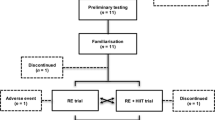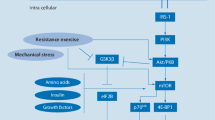Abstract
Purpose
Our aim was to compare the effects of a single exercise training mode (resistance exercise) with a combined exercise training (resistance and plyometric exercise) mode on satellite cell activity and anabolic signaling at the molecular level.
Methods
Eighteen male weight lifters (20 ± 4 years, BMI 27 ± 6 kg/m2) were randomly assigned to either a series of resistance exercise or a series of combined exercise group. The intensity of the exercise was set at 60% of their 1 RM weight and subjects completed three sets each of six repetitions. The combined exercise group performed three different types of resistance exercise alternating with three different types of plyometric exercise, whereas the resistance exercise group performed only the three different types of resistance exercise which was repeated twice. Muscle biopsies were obtained the vastus lateralis muscle immediately before and 3 h after one bout of exercise.
Results
Exercise induced increases in satellite cell activation and myofibrillar protein synthesis following both exercise modes, but the resistance exercise group was superior compared to the combined exercise group in satellite cell activity expressed by Ki67/CD56 (165 vs 232%) and PI3K/Akt protein expression (121 vs 157%), mTOR protein expression (117 vs 288%), p70S6K protein expression (253 vs 809%), and 4E-BP1 protein expression (70 vs 139%) of anabolic signaling pathway.
Conclusions
These results suggest that the previous findings showing a greater effect of combined as opposed to a single exercise mode could be the effect of a greater training volume rather than a true-training effect of a combined exercise program.







Similar content being viewed by others
Abbreviations
- ANOVA:
-
Analysis of variance
- EIF4EBP1:
-
(4E-BP1) eukaryotic translation initiation factor 4E binding protein 1
- elF2Bɛ:
-
Eukaryotic translation initiation factor 2Bɛ
- MAPK:
-
Mitogen-activated protein kinase
- mTOR:
-
Mammalian target of rapamycin
- p70S6K:
-
Ribosomal protein S6 kinase
- Pax7:
-
Paired box protein Pax-7
- PI3K:
-
Phosphatidylinositide 3-kinases
- RM:
-
Repeated maximum
- SD:
-
Standard deviation
References
Adams K, O’shea JP, O’shea KL, Climstein M (1992) The effect of six weeks of squat, plyometric and squat-plyometric training on power production. J Appl Sports Sci Res 6:36–416
Allen DL, Roy RR, Edgerton VR (1999) Myonuclear domains in muscle adaptation and disease. Muscle Nerv 22(10):1350–1360
Bergstom J (1962) Muscle electrolytes in man. Scand J Clin Lab Invest 68:1–110
Booth FW, Tseng BS, Fluck M, Carson JA (1998) Molecular and cellular adaptation of muscle in response to physical training. Acta Physiol Scand 162:343–350
Brito J, Vasconcellos F, Oliceira J, Krustrup P (2014) Short-term performance effects of three different low-volume strength-training programmes in college male soccer players. J Hum Kinet 40:121–128
Cermak NM, Snijders T, McKay BR, Parise G, Verdijk LB, Tarnopolsky MA, Gibala MJ, Van Loon LJ (2013) Eccentric exercise increases satellite cell content in type II muscle fibers. Med Sci Sports Exerc 45(2):230–237
Chan AY, Dyck JR (2005) Activation of AMP-activated protein kinase (AMPK) inhibits protein synthesis: a potential strategy to prevent the development of cardiac hypertrophy. Can J Physiol Pharmacol 83:24–28
Cronin JB, McNair PJ, Marshall RN (2002) Is velocity-specific strength training important in improving functional performance? J Sports Med Phys Fit 42(3):267–73
Dillon KW, Christopher SF, Micah JD, Jared MD, Kyle LT, David MG, Kristofer J, Elena V, Blake BR (2012) Pax7+ satellite cells in young and older adults following resistance exercise. Muscle Nerv 46:51–59
Dreyer HC, Blanco CE, Sattler FR, Schroeder ET, Wiswell RA (2006) Satellite cell numbers in young and older men 24 h after eccentric exercise. Muscle Nerv 33(2):242–53
Hara K, Maruki Y, Long X, Yoshino K, Oshiro N, Hidayat S, Tokunaga C, Avruch J, Yonezawa K (2002) Raptor, a binding partner of target of rapamycin (TOR), mediates TOR action. Cell 110(2):177–89
Hawke TJ, Garry DJ (2001) Myogenic satellite cells: physiology to molecular biology. J Appl Physiol 91:534–551
Hodgson M, Docherty D, Robbins D (2005) Post-activation potentiation: underlying physiology and implications for motor performance. Sports Med 35:585–595
Holz MK, Ballif BA, Gygi SP, Blenis J (2005) mTOR and S6K1 mediate assembly of the translation preinitiation complex through dynamic protein interchange and ordered phosphorylation events. Cell 123(4):569–80
Honberger TA, Stuppard R, Conley KE, Fedele MJ, Fiorotto ML, Chin ER, Esser KA (2004) Mechanical stimuli regulate rapamycin-sensitive signalling by a phosphoinositide3-kinase, protein kinase B and growth factor independent Mechanism. Bioche J 380:795–804
Kadi F, Fredrik J, Rikard J, Mikael S, Jan H (2004) Effects of one bout of endurance exercise on the expression of myogenin in human quadriceps muscle. Histochem Cell Biol 121:329–334
Kotzamanidis C, Chatzopoulos D, Michailidis C, Papaiakovou G, Patikas D (2005) The effect of a combined high-intensity strength and speed training program on the running and jumping ability of soccer players. J Strength Cond Res 2005 19(2):369–75
Kumar V, Atherton PJ, Selby A, Rankin D, Williams J, Smith K, Hiscock N, Rennie M (2012) Muscle protein synthetic responses to exercise: effect of age, volume, and intensity. J Gerontol A Biol Sci Med Sci 67:1170–1177
Kurosaka M, Naito H, Ogura Y, Machida S, Katamoto S (2012) Satellite cell pool enhancement in rat plantaris muscle by endurance training depends on intensity rather than duration. Acta Physiol 205:159–166
Laplante M, Sabatini DM (2012) mTOR signaling in growth control and disease. Cell 149(2):274–93
MacDonald CJ, Lamont HS, Garner JC (2012) A comparison of the effects of 6 weeks of traditional resistance training, plyometric training, and complex training on measures of strength and anthropometrics. J Strength Cond Res 26(2):422–31
Mackey AL, Esmarck B, Kadi F, Koskinen SO, Kongsgaard M, Sylvestersen A, Hansen JJ, Larsen G, Kjaer M (2007) Enhanced satellite cell proliferation with resistance training in elderly men and women. Scand J Med Sci Sports 17:34–42
Mackey A, Kjaer M, Charifi H, Henriksson J, Bojsen-Moller J, Holm L, Kadi F (2009) Assessment of satellite cell number and activity status in human skeletal muscle biopsies. Muscle Nerv 40(3):455–465
Magnuson B, Ekim B, Fingar DC (2012) Regulation and function of ribosomal protein S6 kinase (S6K) within mTOR signaling networks. Biochem J 441:1–21
Maio Alves JM, Rebelo AN, Abrantes C, Sampaio J (2010) Short-term effects of complex and contrast training in soccer players’ vertical jump, sprint, and agility abilities. J Strength Cond Res 24(4):936–41
Mauro A (1961) Satellite cell of skeletal muscle fibers. J Biophys Biochem Cytol 9:493–495
Mihalik JP, Libby JJ, Battaglini CL, McMurray RG (2008) Comparing short-term complex and compound training programs on vertical jump height and power output. J Strength Cond Res 22(1):47–53
Montarras D, L’Honore A, Buckingham M (2013) Lying low but ready for action: the quiescent muscle satellite cell. FEBS J 280:4037–4050
O’Reilly C, McKay B, Phillips S, Tarnopolsky M, Parise G (2008) Hepatocyte growth factor (HGF) and the satellite cell response following muscle lengthening contractions in humans. Muscle Nerv 38(5):1434–1442
Ogasawara R, Fujita S, Hornberger TA, Kitaoka Y, Makanae Y, Nakazato K, Naokata I (2016) The role of mTOR signalling in the regulation of skeletal muscle mass in a rodent model of resistance exercise. Sci Rep 6:31142
Philippou A, Halapas A, Maridaki M, Koutsilieris M (2007) Type I insulin-like growth factor receptor signaling in skeletal muscle regeneration and hypertrophy. J Musculoskel Neuronal Interact 7(3):208–18
Rennie MJ, Wackerhage H, Spangenburg EE, Booth FW (2004) Control of the size of the human muscle mass. Ann Rev Physiol 66:799–828
Rosenblatt JD, Parry DJ (1992) Gamma irradiation prevents compensatory hypertrophy of overloaded mouse extensor digitorum longus muslce. J Appl Physiol 73:2538–2543
Sakamoto K, Goodyear LJ (2002) Exercise effects on muscle insulin signaling and action: intracellular signaling in contracting skeletal muscle. J Appl Physiol 93:369–383
Sengupta S, Peterson TR, Sabatini DM (2010) Regulation of the mTOR complex 1 pathway by nutrients, growth factors, and stress. Mol Cell 40(2):310–22
Skovgaard C, Brandt N, Pilegaad H, Bangsbo J (2016) Combined speed endurance and endurance exercise amplify the exercise-induced PGC-1α and PDK4 mRNA response in trained human muscle. Physiol Rep 4(14):e12864
Snijders T, Verdijk LB, Smeets SJ, Mckay BR, Senden MG, Hartgens F, Parise G, Greenhaff P, van Loon JC (2014) The skeletal muscle satellite cell response to a single bout of resistance-type exercise is delayed with aging in men. AGE 36:9699
Souza HC, Tezini GC (2013) Autonomic cardiovascular damage during post-menopause: the role of physical training. Aging Dis 4(6):320–328
Terzis G, Georgiadis G, Stratakos G, Vogiatzis I, Kavouras S, Manta P, Mascher H, Blomstrand E (2008) Resistance exercise-induced increase in muscle mass correlates with p70s6 kinase phosphorylation in human subjects. Eur J Appl Physiol 102(2):145–152
Tillin NA, Bishop D (2009) Factors Modulating post-activation potentiation and its effect on performance of subsequent explosive activities. Sports Med 39:147–166
Tobin DP, Delahunt E (2014) The Acute effect of a plyometric stimulus on jump performance in professional rugby players. J Strength Cond Res 28(2):367–372
Verney J, Kadi F, Charifi N, Feasson L, Saafi MA, Castells J, Piehl-Aulin K, Denis C (2008) Effects of combined lower body endurance and upper body resistance training on the satellite cell pool in elderly subjects. Muscle Nerv 38:1147–1154
Author information
Authors and Affiliations
Corresponding author
Additional information
Communicated by William J. Kraemer.
Rights and permissions
About this article
Cite this article
Lim, C.H., Luu, T.S., Phoung, L.Q. et al. Satellite cell activation and mTOR signaling pathway response to resistance and combined exercise in elite weight lifters. Eur J Appl Physiol 117, 2355–2363 (2017). https://doi.org/10.1007/s00421-017-3722-x
Received:
Accepted:
Published:
Issue Date:
DOI: https://doi.org/10.1007/s00421-017-3722-x




